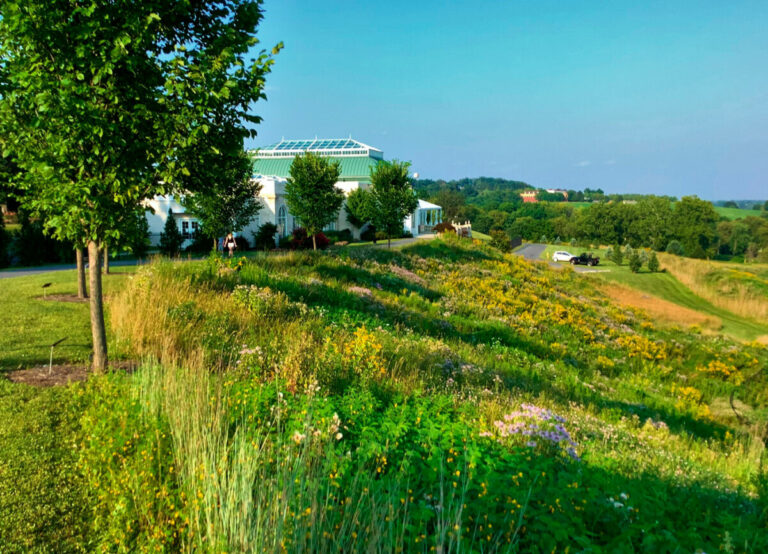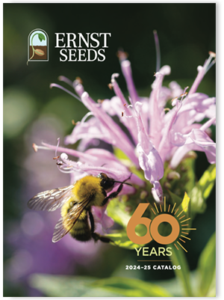Creating habitat for pollinators is one of the most effective and efficient ways we can naturalize our landscapes.
By establishing healthy, diverse wildflower meadows with the intent to accommodate native pollinators, landscape architects can combine sustainability with design.
In 2016, Bill Kieffer, a landscape architect at Hershey Gardens, partnered with Ernst Seeds to build a 3-acre pollinator meadow in Hershey, Pennsylvania. The goal of the project was to create natural erosion control that doubles in functionality for native pollinator habitats.
The project resulted in a biodiverse wildflower meadow that offers season-long habitat for pollinators and fundamentally improved the ecosystem of the gardens.
Taking an Inventory of Existing Ecological Quality
Before the meadow’s implementation, the area consisted of a mowed field adjacent to a parking lot and a steep bank. The bank suffered erosion risks and Kieffer, a landscape architect of over thirty years, was tasked with developing a natural mitigation strategy for it. In doing so, he designed the wildflower meadow that would not only provide natural long-term erosion mitigation but would also create a sustainable habitat for pollinators and local wildlife. The 3-acre plot of land provided a large enough space for the meadow to become self-sustaining and thrive independently with minimal maintenance.

The site was located in the Hershey Gardens that overlook Hersheypark, giving visitors to the gardens a natural area to see wildlife and learn about sustainability. This provided Hershey Gardens the opportunity to create not only a pollinator-focused habitat but also a mode of public education. The adjacent butterfly conservatory at Hershey Gardens now takes full advantage of the influx of pollinators, using it as a source of educational programs and sustainability demonstrations.
Building a Wildflower Meadow From the Ground Up
Planning for the meadow started in 2016 and development began that same spring. Due to the meadow’s multipurpose nature, a customized seed mix was developed to boost native pollinator populations without blocking the viewpoint of the gardens and the adjacent Hersheypark.
Ernst Seeds worked closely alongside Kieffer to develop a special seed mix for the project. The seed supplier offered hands-on support in the seed selection process and development of the meadow, playing an active role in the field’s transition to a diverse pollinator meadow. Kieffer describes Ernst Seeds as a “wealth of knowledge on every subject,” answering every question and guiding the project towards success with expert counseling on native plantings.
The custom seed mix was composed primarily of native grasses intended to sustain the biodiversity of the meadow while maintaining the site’s erosion control. A small portion of the seed mix was dedicated to native wildflowers chosen to support a wide variety of local pollinators. All of the seeds selected were native to Pennsylvania and suited to the northeast climate.

The meadow had fully grown in with the wildflowers and grasses two years after the initial plantings. By the fourth year, all of the plants were fully established and self-sustaining.
“With the exception of spot-treating four or five aggressive invasive species and seasonal mowings, the meadow is fully self-sustaining and the plants never need fertilizer or other treatments,” Kieffer said.
The regenerative 3-acre meadow now has the freedom to develop and change naturally over time with minimal human involvement while still maintaining a healthy ecosystem.
Kieffer describes the meadow as a changing, dynamic landscape. “Variety in the plantlife changes with the seasons, where some plants prefer wetter or dryer years, or warmer or colder. This gives the meadow a lot of variety on a year to year basis,” he said.
The dynamic plantlife and minimal human interference not only gives the meadow freedom to change and grow, but it gives pollinators a variety of food sources every year.
Inviting Pollinators Back Home
As a result of the meadow’s minimal disturbances, it’s become a healthy habitat and food source for a multitude of local pollinators, including native butterflies, bees and other insects. The ecological makeup of the meadow naturally changes with each season, offering a diverse variety of flower species that attract countless pollinators to the gardens.
Surprisingly, the pollinators are not the only ones drawn to the meadow. Kieffer reports seeing a significant increase in wildlife since the meadow’s establishment beyond the anticipated pollinators. The wildflowers attracted native pollinators to the meadow, which in turn attracted birds and insects that feed on them.
“The meadow creates a smorgasbord of butterflies, bees and flies that attract animals up the food chain,” he said.
The trophic cascade that resulted from the wildflower meadow brings in wildlife from every facet of the food chain. Birds now come in droves to the gardens as a result of the increase in insects, and birds of prey are seen flying above the meadows in search of the mice and voles that inhabit the native grasses.
The meadow now provides habitat for a vast majority of wildlife previously unseen in the gardens. Praying mantids are seen covering the trees around the adjacent parking lot, giving visitors exposure to a species considered by many to be a rarity in urban areas like Hershey. Even from a distance, the gardens are seen being circled by songbirds, hawks and butterflies, turning the field into a lively source of active wildlife.
Offering a Glimpse into Local Ecology
Since the establishment of the pollinator meadow, the gardens have experienced a surge of visitors coming to see the local wildlife and interact with the ecosystem on a more intimate level than what was previously possible. The gardens provide access to wildlife and sustainability education in an area heavily developed by urbanization and agriculture. By offering an accessible connection to local nature, visitors are given a look into their local ecosystems that they didn’t previously have.
Currently the meadow is being left alone with no further alterations or development, allowing the ecosystem to evolve on its own. The influx of pollinators and wildlife is expected to continue and caretakers are continuing to monitor changes in pollinator and songbird populations around the gardens.
Developing a wildflower meadow that attracts key pollinators requires careful seed selection to bring your concept to life. Contact Ernst Seeds for more information about how native seed mixes can benefit pollinator populations in landscape design projects.


